|
AlienMind
The Verdants
Large-Scale Disagreements
11-10-2005
Phillip Krapf
worked as Metro Editor for the Los Angeles Times,
until retiring in the mid-1990’s. According to Krapf, less than two
years later in 1997 he was taken up for a three day visit on a
large, disk-shaped craft owned by “the Verdants”—thin, slightly
bulge-eyed aliens with large heads; roughly 5’ 6” inches tall. Krapf
says the Verdants’ skin is either white or tan, with greenish tints,
and that they have slightly pointed ear tips. An earnest,
well-regarded journalist who speaks with no outward sign of
dishonesty, Krapf suggests that he may have been selected for the
encounter because he’s a reputable professional who had previously
been skeptical about aliens and UFO’s. Krapf won a Pulitzer Prize as
editor of what was then one of the best newspapers in the country.
He did fact checking and was responsible for steering reporters and
removing inaccuracies in their stories. Given his conservative,
mainstream stature, he may be the most well-regarded witness of his
sort, to date.
In two recent books Krapf writes that in fully conscious encounters
with the Verdants, a sexually-reproducing population of 500 trillion
individuals, the Verdants told Krapf that Verdants live for
thousands of years and that Verdants currently inhabit 246,000
different planets. Krapf was told that the Verdants are from a
galaxy that is 14 million light years away. His writing is
remarkably detailed, and, in overall terms, is consistent with
reports by hundreds of persons who claim to have encountered gray
aliens. (See the writings of Dr. John Mack, Budd Hopkins and David
Jacobs for further details.)
If true, Krapf’s story would be the second full-length,
minute-by-minute account about an open alien attempt at diplomatic
interaction with fully-conscious humans. The first was
Alec Newald’s
book, Coevolution, about a ten-day journey to the planet of a
competing alien group called the Elders. *There have been other
books about interactions that some readers might consider
diplomatic, yet they were neither as prolonged and explicit, nor as
recent as Krapf’s and Newald’s books, in which aliens appear to have
gone out of their way to accommodate the writers by providing
psychotronically effected, near-total recall. Apparently, this was
done in order to facilitate publication of both stories. Given the
frequency of recent contacts and sightings, paralleled by a cryptic
dribble of human official disclosures, these three books stand out
in a fast-developing, new context. Krapf writes that he was taken
for a second visit with the Verdants three years later in 2000.
Krapf reports that, so far, Verdants have persuaded 17,000 other
non-Verdant planets to join under their umbrella, adding yet another
150 trillion aliens to their empire (which touts itself as a
collective). Each of the additional 17,000 planets is reportedly
inhabited by a different alien species. Given that a large galaxy
like our own contains roughly 150 billion stars, there should be
many habitable planets in a typical galaxy. So, we shouldn’t
conclude that Verdant numbers mean that they control a number of
other large galaxies. A single large spiral galaxy could contain
most of the Verdant alignment.
Krapf says his Verdant contacts informed him that they were the only
colonizers they knew of in the universe. If true, this would mean
they’re probably more manipulative than non-colonizing aliens. Krapf
says Verdants call their umbrella the Intergalactic Federation of
Sovereign Planets, or the IFSP. If Krapf is correct, we live within
reach of a galaxy (14 million light years away) inhabited by
colonizing Verdants who speak in terms of a federated structure,
which implies a central, over-riding authority. Verdant incursions
here, some of which reportedly involve gray alien abductions of
humans, may have accelerated our awareness of off-world dynamics. Krapf writes that in a series of meetings on a 1 ½ mile diameter,
disk-shaped Verdant ship with many windows and entry ports, Verdants
admitted that they have orchestrated years of human abductions for
scientific and breeding purposes prior to attempting a diplomatic
opening to humankind. Electrogravity was apparently used to slow
certain brain processes and render abductees semi-conscious so that
they wouldn’t remember such events.
Krapf says that Verdants have contacted roughly 800 human
“ambassadors,” persons chosen by the Verdants, not by humans, to
help initiate relations with the Verdant contingent aboard ship.
Krapf further says that while onboard he saw at least one US citizen
of national stature being led on a tour of the disk. While in the
disk, Krapf learned that a Times Mirror executive (LA Times) was
tentatively part of the program. Krapf later spoke with the man, who
fearfully admitted involvement. Krapf saw a list plus photos of
hundreds of other human contacts for the Verdant diplomatic
initiative. For yet-unspecified reasons, the projected Verdant
opening was delayed several years past its planned date. Krapf says
the Verdants he met seemed reticent yet certain that Verdants would
succeed in setting the agenda here, which seems ironic because
Verdants proposed that they be allotted 600 square miles of empty
land in the US Southwest to build a center for interaction with
humans.
Of course, it’s difficult to imagine that the people of this planet
would want an alien colonizer to occupy our system. Verdants should
have known better, given their reported study of human affairs. So,
in a sense, if Krapf’s story is correct, the delay in an opening by
the Verdants isn’t simply a delay. Instead, it may be due to the
fact that the Verdants have little chance here, yet due to wishful
thinking within their bureaucracy, plus the extent of their
abduction and breeding infiltration of certain human sectors, they
must go through the motions of an opening (if not some bitter,
last-minute attempts at manipulating humans toward such ends).
Apparently, further delays diminish the Verdants’ chances here
because humans become more technologically capable and informed with
time.
Note: in December of 2004 one highly advanced, non-IFSP alien who
has been critical of the Verdants reported that the Verdants have
successfully planted “between 3000 and 4000” of their direct
operatives in human societies. Of course, this number doesn’t
include common abductees and casual experiencers. Instead, it refers
to individuals who, unknown to other humans, work directly for the
Verdant IFSP to bend human events in favor of IFSP (Intergalactic Federation of
Sovereign Planets) control here.
Such humans may have genetic and other IFSP contributions that go
unnoticed. The source for this report and his colleagues have
provided breakthrough information at various junctures. Leery of
damages done by IFSP manipulators, they seem to want to help humans.
We can probably assume that the IFSP would prefer to steer its
operatives toward high-level positions. In later chapters, this
primer outlines methods for distinguishing between a normal human
and an IFSP “direct operative.” Based upon simple negative energy
aspects of remote sensing, this method can be practiced by most
humans. First, you must practice remote sensing, which uses the
human nerve structure to “feel” around those sites or events that
involve IFSP aliens and look for their signature kind of electrogravity streaming. Such
electrogravity streams stand out
starkly, compared to the ambient background, and usually trace back
to an IFSP technology site instantaneously. What makes this easy is
that fact the different kinds of electrogravity used by different
populations have different energy signatures (especially the
psychotronic component).
Given that such electrogravity streams are
full of detailed information content, sorting them out is fairly
easy, once a person has learned to:
a) recognize and be sensitive to
them
b) to practice sensing them by concentrating on a given
site or by paying careful attention to electrogravity streams during
interactions with aliens
Although a less common option, the latter
method is quite effective. Advanced remote sensing can even detect
past IFSP interactions with the “direct operative” in question. This
is possible because electrogravity (and negative energy) span and
connect outwardly (and inwardly) more extensively than is often
immediately apparent.
There are variations on the theme, of course: some humans may be
unusually talented in identifying “direct operative” IFSP
individuals.
Author’s note: no direct harm is intended to any
individual, and readers should know that those who simply sympathize
with, or are more generally entranced by new alien encounters are
not considered “direct operatives.” Direct operatives would have no
compunction about doing harm to both this planet and its inhabitants
in order to serve the IFSP agenda, while a mere aficionado would
recoil at the thought. (Krapf isn’t a direct operative.)
The
situation is quite serious because Verdant resources would have
allowed them to give material and other advantages to their direct
operatives over many years’ time. Given the Verdant record
elsewhere, Verdant designs on the resources and energy environment
here could be cause for concern.
For example, as
Phillip Krapf notes in his first book, in the past,
Verdants have assigned IFSP (Intergalactic Federation of
Sovereign Planets) parties to monitor some reluctant
conscript planets (considered hostile) in order “to maintain the
(IFSP) program of sabotage in the event future generations might
once again try” to go into space.
-
Verdants told Krapf they were
referring to warlike populations that Verdants had encountered, but
the same attitude may apply to all who reject a Verdant incursion.
-
Verdants told Krapf that, in some past cases, Verdant sabotage has
led to manipulated warfare on some planets, the destruction of
others.
-
One Verdant told Krapf Verdants infiltrated some 10,000 of
their operatives onto one planet, allowing them to become “heads of
military units, key scientists, government leaders, and chief
executives of industrial complexes, including armament
manufacturers. Through sabotage, subterfuge, misdirection,
persuasion over great masses of the host populations, and careful
manipulation of government policy,” Verdants achieved their ends on
the given planet.
(The Challenge of Contact, p. 76-77)
Phillip Krapf reports that on his first three-day visit to the
Verdants’ disk-shaped cruiser he was “shown a roster of many of the
important (Earth) people who had been recruited as Ambassadors,
which was a virtual Who’s Who of the World.” Ambassadors are humans
reportedly taken to the Verdant ship to be indoctrinated, then used
in a Verdant plan to absorb planet Earth within the IFSP. (The
Challenge of Contact, p. 13)
The matter is mentioned here because it relates to Verdant thinking
and behavior in our vicinity. Given the diversity and independence
of most human societies, the Verdants’ prospects here would seem
dim. If such is the case, then planet Earth would be a foreign
policy failure. Bad feelings and resentful last-minute gestures
could be expected. Expansionist designs of the sort do not die
pleasantly.
What do US officials have to say about aliens visiting Earth?
Perhaps the most famous commentary was written by Col. Phillip Corso, an Army specialist who served in Eisenhower’s White House and
in the Pentagon. In his 1998 book,
The Day After Roswell, Corso
claimed that he worked on a Pentagon project to distribute and
reverse-engineer technology gathered from downed gray alien craft.
Corso’s book was the first full-length, high-level disclosure of the
sort. Senator John Stennis wrote a glowingly favorable preface for
the book, but then tried to retract it later.
Writing with co-author
and UFO magazine publisher William Birnes, PhD, Corso suggested
that, beginning with Harry Truman and climaxing with
the Eisenhower
administration, US defense and intelligence officials privy to an
alien crash at Roswell began to fear that grays and affiliated
aliens posed a threat. Part of the fear is attributed to frustration
within the military, the inability to either explain or compete with
such aliens; part of it may have been a kind of spin that was put on
the subject during the editing process.
Despite the fact that Corso says he worked on an Army project to
distribute recovered alien technology so that it could be copied by
US corporations without necessarily betraying the technology’s
origin, Corso’s experience occurred quite early in the history of
human-alien interactions. Corso wrote that military colleagues
suspected that grays were alive, yet robotic in some strange,
implanted way. Decades later, however, there is evidence that grays
are sentient beings capable of very human-like error.
More will be said about Verdants and grays later, but for now the
case provides at least one explicit example of a large alien empire,
or collective. Readers should bear in mind that in all probability,
the Verdants represent little more than the dominant population of
one large spiral galaxy 14 million light years distant from our own.
Due to their trading prowess, they may be influential in the other
galaxies that they’ve fingered into, as a minority occupier.
Verdants reportedly told Krapf they’re from a galaxy group that,
like our own galaxy group, is located out on the fringes of the
Virgo supercluster of galaxies. The Virgo supercluster contains some
2000 galaxies.
In short, Verdants would represent but one galaxy out
of a vastly larger 50 billion to 100 billion galaxies within the
larger, visible universe. Alien competitors of the Verdants go out
of their way to emphasize this fact with specific reference to the
Verdants, by the way. Further reports have partly corroborated
Krapf’s story about the Verdants. For example, hundreds, if not
thousands of witnesses say they have encountered gray aliens working
on a breeding program, which is further evidence of the current
Verdant-IFSP presence in our system. Because abducteé and
experiencer reports from all over the globe often mesh consistently,
we should give Krapf’s reports their due consideration.
The
Verdant case helps to illustrate the fact that there are noisome
disagreements on an inter-galactic scale. Along with others in the
human telepathic community (an open commonality), I have interacted
and disputed with Verdants, as strange as that may sound to some
readers. Disputes arise because, like many humans, I’m actively
critical of Verdant-gray intentions. Prior to reading Krapf’s book I
had no clearly defined context in which to identify Verdants (who
were extant at the time) because Verdants normally try to obscure
themselves behind lesser, dependent aliens of their group, i.e. the
grays and human-gray hybrids. It’s both a matter of pride and
official priority that they do so.
After
Krapf’s book was published, specific details about numerous of
my own, ongoing interactions became clear. Although I disagree with
aspects of Krapf’s story, i.e. Verdant remarks about an “angelic”
intermediary for their contacts with humans (a sop that smacks of
Verdant propaganda), most of it is earnest and informative. At
present, Verdants can be remotely discerned, easily. As is noted
above, they can be investigated using techniques to be described in
later chapters. *Caution is advised, however.
The Verdant story is outlined in a way that brings together
important, previously unspecified pieces of a very large puzzle. One
large, native coalition of Milky Way and other, related aliens has
repeatedly issued warnings about the Verdant-gray abduction and
breeding scheme, which is described as a violation, an illegal
intervention by an oversized abuser here along the outer fringes of
the Virgo supercluster. The Verdants are cited for provoking
militarization and the infiltrated sabotage of other worlds’
ecologies.
Before delving into the subject further, I should note that the
history of alien political disputes in our small part of the
universe is mentioned here for one specific reason. It figures high
in the minds of neighboring aliens and is intrinsic to an
inter-alien dynamic that humans are just beginning to discern. It is
of epochal significance to the human population, yet may be seen as
a kind of garden variety item in larger cosmic news reports. In a
larger context, there are much greater considerations.
No respectable alien will deny that major issues are at stake in the
human struggle against an intervention that features a breeding
program and the manipulation of religious and economic conflicts.
Some readers may disagree with the assertion, yet it’s based on
numerous reports by black budget whistle-blowers, abductees and
other experiencers, plus aliens who can easily be identified.
There’s an urgent tone in such messages. *In a larger sense, one can
imagine an alien sitting in a neighboring galaxy supercluster and
reading about the situation here, then wincing because it reminds
him/her of a similar situation there.
|

The Universe
within 12.5 Light Years
The Nearest Stars |
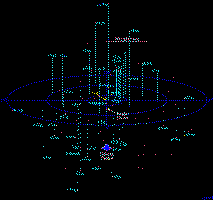
The Universe
within 250 Light Years
The Solar Neighbourhood |
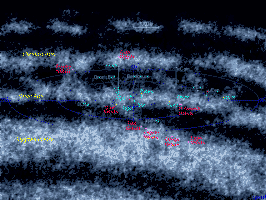
The Universe
within 5,000 Light Years
The Orion Arm |
|
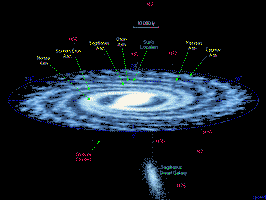
The Universe
within 50,000 Light Years
The Milky Way Galaxy |
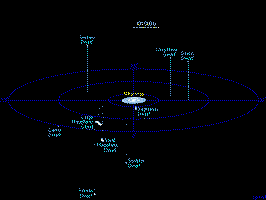
The Universe
within 500,000 Light Years
The Satellite Galaxies |

The Universe
within 5 million Light Years
The Local Group of Galaxies |
|
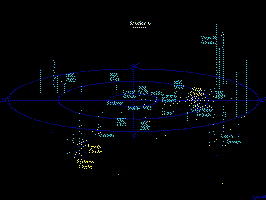
The Universe
within 100 million Light Years
The Virgo Supercluster |
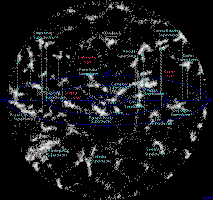
The Universe
within 1 billion Light Years
The Neighbouring Superclusters |
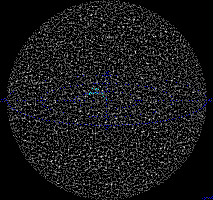
The Universe
within 14 billion Light Years
The Visible Universe |
|
click images
to enlarge
Our galaxy is just one of
thousands that lie within 100 million light years.
The above maps shows how galaxies tend to cluster into
groups, the largest nearby cluster is the Virgo cluster
a concentration of several hundred galaxies which
dominates the galaxy groups around it. Collectively, all
of these groups of galaxies are known as the Virgo
Supercluster. The second richest cluster in this volume
of space is the Fornax Cluster, but it is not nearly as
rich as the Virgo cluster. Only bright galaxies are
depicted on the map, our galaxy is the dot in the very
centre.
from
TheAtlasOfTheUniverse
Website |
Incidentally, the galaxy M-83 matches both the size, and the
location that Phillip Krapf describes as being home to the Verdants.
M-83 is a spiral galaxy located in the Centaurus A galaxy group. A
few alien sources have suggested that M-83 is, in fact, the Verdant
home. In addition, one highly detailed map was communicated to
indicate Verdant outposts in other galaxies. In the map,
communicated by an alien significantly more evolved than the Verdants who monitors the situation here closely,
Verdant IFSP
outposts are concentrated in the Centaurus A galaxy group, primarily
centering on the galaxy M-83, but fingering into other galaxies of Centaurus A.
If I’m not mistaken, the Verdants aren’t the most
numerous population in the other two large spirals of their home
galaxy group. Instead, other native populations are more numerous.
Verdant outposts also finger lightly into galaxies of the five
galaxy groups nearest Centaurus A: Sculptor, Maffei,
M-81, our own
Andromeda-Milky Way group, and Canes I, which broadens out into the
Virgo supercluster of galaxies. Apparently, as is noted later in
this book, the native populations of those five galaxy groups
are
dominant there, not the Verdants. All five galaxy groups are small
groups containing but 3-7 large galaxies and a few dozen smaller
irregular or elliptical galaxies.
Although some who are new to alien studies would like to think that
aliens are all about electrogravity, interstellar travel, and
community of mind, they aren’t. The main concern communicated by
aliens, at present, is the universal ecology. Why the ecology?
Because there are no unlimited quantities in the known universe.
Rather than assume that unoccupied territory is simply open for the
taking, humans have been advised to remember that all large galaxies
are already inhabited by advanced civilizations. In other words, the
most important task for humans, now, is to be self-sufficient and
learn about more responsible alien populations, rather than stumble
out in pig-headed search of real estate.
Some humans assume that they have always gone about their business
without setting limits on population and wealth, yet in a more basic
sense, every family makes such decisions daily. For all humans to do
what most of us have done—to forego a life of material excess and
limit one’s family—is not a major stretch of the imagination. Should
we continue down our present, one-way street toward global
ecological breakdown, we can expect the larger off-world community
to either distance itself from the regimes here or try to convince
humans to compel a change before we become a threat to our
neighbors. People who interact with aliens say that advisories of
the sort are an everyday occurrence.
That’s food for thought. Maybe we can learn how to avoid global
failure by studying alien social dynamics more rigorously.
-
For
example, how did other planets die?
-
Why did the Verdant IFSP
fail to
persuade multi-planetary mega-populations in other galaxies to join
under its umbrella?
-
Does the failure of the IFSP indicate that a
larger, more effective premise already exists collectively?
-
If such
is the case, how do galaxy supercluster and larger universal
interactions derive their basic conventions?
Aliens touch upon such
themes during interactions with a growing number of humans. Aliens
further suggest that such considerations are now so obvious as to be
mathematically explicit.
A Universal Standard?
After years of experience with different kinds of aliens, we can
begin to make basic distinctions about alien perspectives on
off-world psychology. What I’m about to say may make some readers
uncomfortable, but I’ll say it anyway. The first and foremost
distinction of the sort has to do with the difference between
sexually-reproducing populations (sexuals) and those who reproduce
by cloning or other non-sexual means (non-sexuals). Every single
alien population with whom I’ve interacted has placed strong,
unmistakable emphasis on the difference between sexuals and
non-sexuals.
The difference between a sexual Verdant (subdued yet
collectively aggressive, territorial, and prone to black-outs of
larger perspective) vs. a typical non-sexual “gray” alien is stark.
Grays are more dispassionate and consistent in their analysis, more
capable of admitting error. They are categorically more humble and
are less prone to the stimulus-seeking dimensions of personality
disorder. The same is true of other non-sexuals who have interacted
with humans.
Among alien populations, the sexual vs. non-sexual distinction is
considered so important, so intrinsic to sorting out complex issues,
that a basic non-sexual perspective appears to be the universal
standard. Why is that? Because a non-sexual lifestyle is more
internally consistent, more cool-headed and ecological. Non-sexual
reasoning is less slippery, less prone to pleasure-seeking pitfalls
and specious rationalizations, less distorted by the need to impress
others. Non-sexuals can sustain their thinking more prolongedly and
can develop finer, more detailed kinds of reasoning.
Nonsexuals rarely pose a population risk to the larger universal
ecology—for one simple reason. They can plan and control their
numbers in proportion to their needs and resources. Meanwhile, what
normally determines the amount of sexual procreation? Impulses, a
sense of loneliness, biological urges and, in some cases, a
lingering fear of external threats, a need for protection.
Sometimes, of course, there’s a prescient kind of love for that
future little cutie.
Love, to a good alien, is a larger, more general kind of social
inter-relationship,
a humble search for meaning. In its most intelligent, universal
form, it is an abiding openness,
a truly inspired desire to both feel for, and help, any and all
other
beings in ways that are akin to a kind of mind within mind, within
the hyper-dynamics of exquisite sensitivity. It deliberately reaches
into the most painful depths of suffering to collectively lift the
affected toward a more advanced, albeit transparent kind of
understanding. Even “sex-positive” humans who can see through
themselves to behave responsibly are accepted by such aliens.
The sexual vs. nonsexual theme is recurrent, albeit subdued, in
human-alien interactions and has been mentioned in a variety of
contexts. Sometimes it frames alien criticism of human violence and
excess, i.e. our higher intellect vs. animal impulses. Sometimes it
frames a discussion of sexual escapism and what, to aliens, are
nearly delusional notions of economic refuge. Sometimes sexual vs.
nonsexual themes permeate discussions about evolution and advanced
social dynamics.
Hyper-advanced aliens say that entire planets have
suffered ecological death while the sexually predatory elites
responsible for such disasters continued their escapades right up
until the death of all surface life forms. In some cases, they
competed for sexual opportunity even as they retreated to
underground refuge! Some aliens have posed the following question:
If, in the future, or after you died, you could choose to either
merge with a more advanced kind of universal consciousness or
continue as a human sexual, could you shun the sexual dimension in
order to exist as a higher life-form?
At other times, the sexual-nonsexual theme has been used to
underscore the aggressive intervention, here, by Verdants, who
reportedly dominate the lesser, dependent gray alien population.
Since the story of the Verdant population provides a useful example
of sexual vs. non-sexual behavior, we’ll discuss it briefly before
returning to our main topic.
A Mega-Population Problem Case
Phillip Krapf reports that when he visited the Verdant ship he was
told that in the past, Verdants opted for a genetically selective,
non-sexual reproduction strategy but later chose to return to
sexuality. A Verdant told Krapf that the reversion to sexuality cost
them a significant part of their intellectual ability. If such is
the case, then why did they do so? For some strange reason, no
single Verdant explained their reasoning. The omission speaks
volumes about the larger Verdant outlook.
A closer look at the case suggests that Verdants may have done so in
order to outnumber a competing population in their home galaxy.
Given recent developments in human astronomy, plus non-IFSP aliens’
comments about Verdant history, we can now construct a scenario for
that phase of Verdant history.
Those who briefly studied the website showing our location in the
universe (above
images or visit
this website) will certainly
appreciate the following. The beautiful, star-studded swirl that we
call the Milky Way is part of a group of some 40 galaxies in the
local group, which features our galaxy at one end, and the equally
inspiring spirals Andromeda and M-33 at the other end.
The two Magellenic Clouds and numerous smaller ellipticals complete the
picture. Moving counter clockwise as seen from above, the next
nearest galaxy groups (all similar in size to our group) are:
Sculptor, Maffei, M-81, and the Canes I
 group - which billows out
into the Virgo supercluster, a relatively small supercluster, as the
universe goes. group - which billows out
into the Virgo supercluster, a relatively small supercluster, as the
universe goes.
The fifth closest galaxy group is Centaurus A, which may hold the
answer to why grays and other Verdant-related aliens have abducted
humans on a massive scale. If, as Krapf reports, the Verdant galaxy
is 14 million light years away, then the most likely candidate, in
terms of size and habitability, would be the large spiral galaxy
M-83 (click image left). Competing aliens have repeatedly suggested that M-83 is the
Verdant home galaxy.
While interacting with the pre-noted human
telepathic community, one advanced alien communicated an explicit
map in such regard. Another advanced alien remarked that the Verdants
have prematurely “cooked” M-83 by overusing electrogravity
on a massive scale. He suggested that, by doing so, the Verdants may
have caused certain supernovae in M-83 to explode prematurely, thus
decimating biological planets. When this last remark was stated,
there was a brief exchange between a Verdant and the alleging alien.
The allegation stood unchallenged. Again, this was observed by a
number of different humans.
Some may ask whether we should trust such aliens’ reports. In
response, I should note that some of the alien contingents who visit
our vicinity are on serious, and in some cases, potentially
life-threatening watch (for other aliens). To even be here, in our
vicinity tending to such matters from a distance can be risky. No
alien wants to be responsible for a Verdant seizure of their
technologies, which Verdants reportedly study and sometimes try to
copy. For example, a few years ago, Elder aliens specifically
reported a previous Verdant seizure of an Elder craft, the hull of
which was made of hybridized living materials that allowed it to
reconfigure in cold, empty space.
Apparently, given that the ecology of our planet and that of
surrounding galaxy groups may be jeopardized by a colonial’s
incursion, competing alien sources feel a need to tell the truth
about Verdants. Some alien contingents are so much more
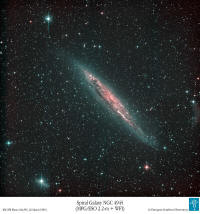 advanced
than the Verdants that they don’t feel threatened. Instead, they
appear to tend to the Verdants in terms of a larger ecological
context. advanced
than the Verdants that they don’t feel threatened. Instead, they
appear to tend to the Verdants in terms of a larger ecological
context.
Should recent reports prove wrong, however, the next most likely
candidate for the Verdant galaxy would be NGC 4945, M-83’s close
neighbor. NGC 4945 (click image right) is a slightly larger spiral than is M-83.
Meanwhile, the galaxy that clearly dominates spiral M-83’s galaxy
group is Centaurus A, a much larger elliptical (nearly round)
galaxy. According to recent astronomers’ data, Centaurus A is the
product of a merger between two large galaxies that was completed
some 10 million years ago---before the present view, that is. Centaurus A is some 12.4 million light years away from us.
Astronomers say the merger may have begun as much as 500 million
years ago. Some suggest that it is now a large elliptical with a
strange dust lane around its perimeter because it’s a large
elliptical that absorbed a modest spiral galaxy about the size of
our close neighbor galaxy, M-33.
Let’s continue our scenario about the Verdant home galaxy. For the
sake of the argument, let’s assume that the Verdant galaxy is M-83,
as has been repeatedly suggested by the alien sources noted above.
As such, we may now have enough data to posit an explanation for the Verdants’ aggressive population growth. According to
Phillip Krapf’s
report, the Verdants developed electrogravity technology some
229,000,000 years ago. Given that other advanced populations
probably existed near M-83 at the time, Verdants could have copied
electrogravity technology from such aliens, much as humans copied
downed gray alien technology more recently.
According to astronomers, M83 has a double nucleus, a double center,
which suggests that, like our neighboring galaxy Andromeda, M83 has
nearly completed a merger with a smaller galaxy. Assuming that there
were intelligent residents in both of the merging components, the
merger may have spurred the Verdants to be more competitive.
Verdants may have worried that merging aliens might out-populate the
Verdants in M83. That, in turn, may be why Verdants ended their
non-sexual status in order to out-populate competitors.
Other pressures may have sped Verdant population growth (numbering
500 trillion, at present, writes Krapf). Beginning as much as
229,000,000 million years ago, Verdants may have seen the pending
merger of two nearby galaxies (now combined in the galaxy Centaurus
A) as a threat to their domain—for one simple reason. Some residents
of the soon-to-merge galaxies would have scouted M-83’s stars for
future homes because their soon-to-form large elliptical galaxy
would be hot and dangerous. Beginning as much as 100 million years
ago, an incursion into M-83 by populations fearing the merger would
have alarmed Verdants.
Had encroaching aliens taken unoccupied
systems in M-83, the Verdants would have wondered whether Verdants
would control their own fate or see their galaxy sped toward a
habitable end in advance of its “normal” lifetime (due to Bearden’s
*t, the speeding of time caused by the use of electrogravity).
Acting out of fear, Verdants may have been further motivated to
overpopulate and expand their domain in order to ward off further
incursions. Perhaps they saw that Centaurus A refugees
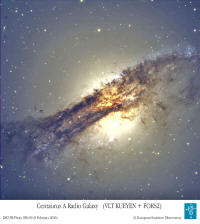 might gain
footholds in other large spirals of the vicinity: the galaxies
NGC4945 and E274-01. might gain
footholds in other large spirals of the vicinity: the galaxies
NGC4945 and E274-01.
Refugees fleeing Centaurus A (click
image left) would have had good reason to be
afraid. Earth astronomers see two huge, cone-shaped remnants of what
is called a “hyper-nova” extending out from opposite sides of a
massive black hole in the center of Centaurus A, which is now a
large elliptical (round-shaped) galaxy. Hyper-novae caused by the
merger of two star-sized black holes are the most violently
explosive events yet observed within the universe. The hypernova
that reportedly exploded in Centaurus A more than 10 million years
ago probably involved black holes that contained millions of solar
masses, hence the event was cataclysmic.
Given that two merging
galaxies deform as they merge, causing some stars to plunge toward
hot central regions of the new galaxy, the Centaurus A hypernova
would have been alarming. If left unshielded, thousands of
potentially habitable planets would have been rendered unlivable. In
fact, the Centaurus A hypernova suggests what may happen on a lesser
scale during a future merger of black holes within M-83’s double
center. *M-83 is considered an “active galaxy” because it emits more
radio and infrared energy from its central active region, perhaps
due to its double center. M-83 is known for an unusual number of
supernova explosions.
Let’s continue the scenario. Presumably, according to one NASA
report issued several years ago, “life is ubiquitous” throughout the
universe. Early life forms eventually evolve into higher
intelligence in all habitable regions of all habitable galaxies.
Given that the vast majority of visible stars lie within galaxy superclusters, it’s only logical to assume that supercluster social
forms and supercluster constraints on overpopulation should, in
theory, prevail across the universe. In a sense, in much the same
way that New York and the world’s major population centers figure in
comparison to Waco, Texas, for example, superclusters should be more
challenging, yet more integrated and urbane than are outlying areas
like the Verdant galaxy group.
Of course, the two-cities analogy falls short in illustrating likely
differences. Suffice it to say, the Verdants may be an oversized but
relatively backward population (socially, albeit not necessarily
technologically---Verdants are highly intelligent). It’s possible
that in some respects, the Verdants may have failed to accord with
the larger supercluster ecology because they didn’t organize a
collective accommodation of Centaurus A refugees within their galaxy
group. Instead, Verdants may have bred to an extreme over the last
100 million years in order to outnumber competitors in M-83 and keep Centaurus A incursions to a minimum.
In one alternative scenario based upon direct quotes by more
advanced “hyperversal” aliens of our vicinity who pre-date humans by
billions of years, the Verdants were greedy, self-rationalizing
expansionists. In late 2004, the given hyperversals explicitly
stated that the Verdants embarked on their population blitz due to a
struggle for control of the original Verdant galaxy. For example,
according to Krapf’s figures taken from direct Verdant quotes,
Verdants take 14 planets for themselves for every 1 occupied by
another species in the IFSP. Worse yet, Verdants populate at 4 times
the rate that all of the other IFSP (Intergalactic Federation of
Sovereign Planets) populations do, on average, a
dangerously unbalanced ratio.
Faced with a potential problem, it
appears that a categorically more advanced population decided to
steer Verdants outward as part of a strategy of eco-tensions---in
part to give eco offenders reason to moderate, in part to show the
Verdants as a teaching example of a failing ecology. There have been
specific remarks by more advanced, “hyperversal” aliens to this
effect (see later chapter about hyperversals). Another hyperversal
alien faction that’s highly critical of the Verdants pointed out
that a Verdant-abetting hyperversal faction has gone out of its way
to find and identify emerging planets for the Verdants to target in
search of conscripts. After learning of this, I and other humans
probed and queried the Verdant-abetting hyperversal aliens, who
monitor the Verdants closely. They eventually admitted that Verdants
have, in fact, been steered toward planets like Earth.
There seems to be a statistical spread in the given hyperversals’
scheme. They appear to encourage intergalactic interactions, in part
to cultivate a better awareness between galaxies, in part to develop
a check on offenders like the Verdants. As a result, when the people
of a planet like Earth begin to learn about aliens and
electrogravity, we quickly gets a sense of intergalactic politics,
plus the need for a larger universal ecology. Apparently, Verdants
are also expected to learn by their encounter with humans, a kind of
lesson that seems to proceed but one world (or galaxy) at a time.
In short, both of the Verdant expansion scenarios above appear to
have at least some validity. Judging by all reports, millions of
years ago the Verdants decided to outnumber their local competitors.
Fateful ironies would have followed. Overpopulation leads to greater
needs: career pressures, resource grabs, the wayward impulses of
those who want to participate in exotic foreign adventures.
According to
Phillip Krapf’s remarkable journals, the
Verdants are
sexuals who are prone to territoriality and the sometimes clouded
judgment that sexuality engenders. In this respect, as in most
others, we see a subtler shading than is noted in humans.
Nonetheless, we can assume that some in the Verdant bureaucracy
suffer neurotic pitfalls that surround the circus-like manipulation
of lesser, off-world peoples. Due to the internal preoccupations of
their far-flung government, in times of crisis Verdant crews will be
pressured to conform to a colonial paradigm. As sometimes happens
within intelligent sub-cultures, the sexually-related weaknesses of
the Verdant elite can be flipped, in a sense, and come to be
regarded as positive attributes, rather than impulsive failings.
As a result, a typical Verdant may regard humans as minor neophytes
from a backward planet and think that Verdants are perfectly right
to intervene here because Verdants are more knowledgeable. After
all, Verdants engage in a vastly larger endeavor. Judging from the
reports of numerous sources, Verdant IFSP propaganda says that
humans need to be “saved” from the ravages of their lesser nature
before planet Earth is ruined. However, few Verdants will confess
that part of the breeding program seeks to infiltrate and gain
control over vital human sectors. In Krapf’s books, Verdants admit
having done that to other planets, and competing aliens allege that
Verdants are doing it here, also.
So, how do Verdants rationalize their aggressive strategy millions
of years after their home galaxy power struggles? Without realizing
it, Verdants sometimes communicate internal assumptions about their
elite qualification to administer others’ affairs, plus other
messages relating to a culture of fear surrounding bureaucratic
challenges to any given Verdant’s competency. Within the vast
colonial heirarchy, such challenges are de rigeur because
Verdants
are often seen supervising younger, less technologically advanced
aliens from non-Verdant planets.
To stay on top, Verdants must be
coldly manipulative, especially during an intervention. In numerous
disputes with Verdants, I’ve noted this pattern repeatedly. For
example, when intruded upon personally, or when I note a violation
of humans in general, I sometimes probe and remotely test an entire
Verdant crew for details of their past and present intentions here.
This is done in flash-like bursts across a larger configuration
space (not in the sense of visible bursts) because it’s a
hyper-dynamic involving the negative cycle outlined in previous
pages.
Sometimes, in response, lesser crewmembers try to demonstrate their
skill at diverting me from identifying a Verdant overseer, all the
while resonating in masculinized, subcultural terms. Their version
of masculinized resonance is less rough-edged and usually more
intelligent than what one might expect among contained-craft humans,
yet it occurs fairly often and has been noted by a number of human
observers. Sometimes I even encounter non-sexual aliens whose
intermediaries verge on masculinized characterizations, albeit
infrequently. In particular, there is one hyper-advanced population
of larger circulation that I refer to as the –X3’s, who, along with
hybrid intermediaries, tend to the Verdant case in a variety of
ways.
* More about the –X3’s and other “hyperversal” aliens in a
following chapter.
Speaking for myself, having long been identified as critical of
Verdant-gray intentions here, I’ve endured thousands of hours of
mostly uninvited remote interactions with IFSP aliens— sometimes of
a passive nature. However, some of it has been threatening and has,
at times, been tangentially framed in terms of a Verdant connection
to one leading US military-industrial family (formerly French
monarchists named Biderman and
Du Pont) in part known for its ties
to organized crime plus a previous family affinity for fascism and a
leading role in what is known as the anti-alien black budget
“Cabal,” ironically---which suggests an attempt to play both sides
of the fence off of each other for advantage.
Native Milky Way and
other advanced aliens have repeatedly pointed out that part of the
given US family (the formerly Swiss branch: Biderman) was “direct”
Verdant operative, possibly a result of the breeding program. The
news caused quite a stir, here, among the human community because it
corroborated a long-running pattern of thinly veiled verbal threats
to humans, a strategy of tension that such aliens have pursued for
years to the chagrin of a growing host of humans. As a result, there
have been sustained, finely networked efforts to probe the suspects
in such regard. The results have been disturbing, frankly.
As is reported in following chapters, non-IFSP aliens who criticize
Verdant overkill have repeatedly reported that the IFSP has “direct
operatives” in a number of specific cases on this planet, one of
whom is reportedly within “the Biderman part of the
Du Pont
family”---the largest, perhaps most reactionary arms manufacturer in
the United States with a long history of supporting death squads and
underworld finance. Another reported “direct operative” is a noted
French financier named “Rothschild,” whose family first appeared on
a major scale by funding both Napoleon’s adventures and his British
opponents.
At first glance, reports about “direct operatives” of the sort high
in the human economy may sound strange, yet given the large,
long-term strategy of the IFSP, we should expect to see
highly-placed direct human operatives. From the Verdant perspective
they would be useful and would help to assure that long-term IFSP
mobilizations (and abductions for breeding purposes) achieve their
desired goal. Earth wouldn’t be the first case of the sort. One
Verdant told Krapf that the Verdant IFSP inserted direct operatives
high into the social line-up on (at least) two other planets.
*Those familiar with US history will recall that
the Bush family has
long been a willing, if not obedient, part of the Du Pont-Dulles
faction of the CIA, perhaps the most corrupt of factions.
Non-federation aliens have gone so far as to state that George Bush
Sr. is also, in some way, a “direct operative” of the IFSP, as weird
as that may sound to some readers. The point has been stated
repeatedly and with emphasis, so it may be important. The subject
was later probed by a broad network of humans, with deeply
disturbing results. I’ll explain how this is done, in later pages.
Having done graduate study in US history, and having worked as an
investigative reporter, I wouldn’t report the quotes unless they
were:
a) repeated numerous times so that a variety of humans could
pick up on them
b) were later investigated to check for direct
personal indications let slip by
Bush Sr., himself
Informative
alien mention was also made of a direct operative named “Gold,”
apparently a Jewish financial figure in New York City. A leading
Saudi family was also noted. It would appear that Verdants have a
multi-fold strategy for manipulating the human situation, at
present. They may be more ruthless than some might expect.
More generally speaking, Verdants appear to have a foreign policy
that places their empire-of-sorts at the center of all related
consideration, from which all other concerns are imagined to radiate
outward. Some Verdants seem to have been spoiled by the luxury of
distant travels, the option to live and work on literally thousands
of planets, plus the chance to study and manipulate lesser
populations up-close. I’ve detected a subdued but droning kind of
lust for sexual adventure among the most coldly dysfunctional old
stalwarts. Apparently, some of the worst cases of the sort are
shipped out to work on the most distant, most primitive planets
targeted for colonization---like planet Earth, for example.
After years of working in such places, some old Verdants become
almost hopelessly corrupted. Imagine what they go through: first
they must breed an obedient surrogate population to help tend to,
and mix with the peoples of the target planet. Such projects involve
the inculcation of primitive belief systems, delusional constructs
prone to schizophrenic pitfalls. Wars must be influenced toward an
eventually pro-federation outcome. IFSP operatives must be
positioned to gain influence over organized crime structures on the
target planet, and breeding program operatives must be placed so
that they control the maximum amount of money and resources without
being exposed for their loyalty to the Verdant colonial scheme. To
some readers this surely sounds strange: corrupt aliens. To those
who know the history of colonialism, it should come as no surprise,
however. Humans aren’t the only kind that can do wrong.
In the end, Verdants who tend to colonial targets can, themselves,
be casualties because they become too dangerous to return to more
psychologically refined postings elsewhere. Some are relegated to
barren outposts like the planet that Phillip Krapf’s Verdant contact
described, a Verdant way station, here, in the Milky Way.
Ultimately, we must ask, how can Verdants maintain so large yet
isolated a string of planets?
How do they prevent the peoples of such planets from assimilating
with their neighbors? Stark differences between crude Verdant
colonial operatives and other, more finely-cultured Verdant
specialists suggest that, like destructive cases of militarism on
Earth, Verdants, too, have devised a stifled, if not infantile kind
of citizenship. To publish ugly details about their most aggressive
foreign policy failures would loosen the cohesion of the larger
empire. So, presumably, they glaze the cake---they overwhelm the
Verdant citizenry with more positive news and scientific reports
about their many planets.
The patronizing attitudes of Verdant crewmembers I’ve encountered
speak volumes in this regard. I’ve seen Verdants who will directly
and intrusively impinge upon any human, irregardless of stature,
i.e. the long-running pattern of thinly-veiled threats noted above
(which, to say the least, has become cause for concern among human
officials). At one time, pre-emptive impulses of the sort may have
helped the Verdants maintain their independence in the face of a
challenge. However, that was during a relatively primitive age,
compared to the current inter-alien context. In a sense, humans are
lucky to begin within a more advanced time.
In the end, like the human disaster of WWII, the mergers within M-83
and Centaurus A would have contributed to a burgeoning Verdant
security apparatus that ultimately defeated its own original
purpose: to preserve the long-term ecology. Worse yet, in order to
maintain their hold on non-Verdant conscript planets, Verdants would
have to surround such planets with an overbearing defense and
technology structure in order to cut them off from neighbors with
whom they might otherwise affiliate, then stray. This may be why
Verdants and grays have reportedly developed limited human-hybrid
offshoot colonies on several planets near our solar system,
ironically. Ultimately, to proceed at such effort and expense would
be costly, tempting Verdants to “mine” the vicinity’s resources in
order to profit by the interaction.
Unlike what happened in the Verdant case, well-managed galaxy
mergers will hasten mixed alien integrations and the refinement of
electrogravity technologies, while placing a limit on population
growth. Indeed, some newly-merged ellipticals galaxies may be
exemplary in this regard. By reducing their populations in advance
and by jointly sharing a newly-merged galaxy, they can set a higher
standard.
Meanwhile, the coalescence of M-83’s double nucleus is long past and
the Centaurus A hypernova crisis was more than 10 million years ago,
yet Verdants haven’t managed to correct their specious impulses.
What single voice, what given Verdant planet would be sufficient to
change the expansionist policy of so large and unwieldy a
population? None, of course. The most likely solution would be a
collective security arrangement between all of the galaxy groups
that surround the Verdant home group, an arrangement that should
eventually include us.
Alternatively, the greatest chance for reform
of the Verdant empire may lie within a coalition of disparate,
non-Verdant planets who may try to democratize the Verdant-dominated
“federation” from within (even if they are a minority). There are
other, more advanced possibilities, including the largely veiled
interventions of hyper-advanced populations who greatly exceed the Verdants.
In my own experience, Verdant males have figured in coldly detached
manipulations intended to take advantage of human misconceptions.
Meanwhile, Verdant females, like human females, seem to be better
adjusted than are their male counterparts. Were Verdant females to
control their government, it would probably be more ecological.
Nonetheless, in a lighter moment, one hyper-advanced
(non-federation) alien remarked that Verdant females are
characterized by an unusual “presence” of mind—a tongue-in-cheek
criticism of the more immediate, stimulus-seeking awareness that
sexuality engenders.
Like Michael Moore’s recent argument that the United States is
really a progressive people just waiting to prevail (64% female and
non-white), most of the universe is probably either female or
non-sexual, which should help to tilt the scales toward larger,
nonviolent interactions.
The Verdant case helps to underscore the differences between sexuals
and non-sexuals, the problems that can arise among populations who
fail to control their growth. Indeed, we now hear competing aliens’
criticisms of the Verdants stated in precisely such terms. Milky Way
aliens should be concerned: the Verdant incursion here is neither a
legitimate case of need, nor does it appear to be entirely
consistent with a supercluster ecology. Instead, it has been
criticized as a security risk to this galaxy, which brings us back
to planet Earth, where abductions continue.
To place the Verdants in context, it helps to remember that Verdants
reportedly number 500 trillion individuals, in total. In the year
2000, one alien of a Milky Way coalition noted above reported, here,
that the largest single population native to the Milky Way numbers
“38 trillion” individuals. Assuming such numbers (essentially the
only ones that we have to date) the largest reported mega-population
in the Milky Way would occupy some ten or thirteen thousand planets,
if the Verdant ratio of advanced aliens per planet holds true here,
also. In addition, we can assume that some more advanced
“hyperversal” aliens (part of a universal network of various
hyperversals) reside within the Milky Way. They may interact with,
and at least partly constitute every major galaxy’s largest
coalitions. As such, the Milky Way would more closely approximate a
desired universal ecology.
Reckless population growth like that of the Verdants (reportedly 13
times more numerous than the largest Milky Way population) would be
destabilizing. Moreover, if Krapf’s figures are correct, Verdants
take 14 planets for themselves for every new member planet that
joins them, a dangerously skewed and undemocratic ratio.
*Note: In
late May 2004, one hyper-advanced alien mentioned that a neighboring
population of hyperversals (who I refer to as “the –X3’s”) is either
1.5 times as numerous as the Verdants, or some 1.5 quadrillion in
number—yet this last quote was so fleeting, albeit resonated
variously later, that it should be regarded as tenuous. There may be
more to the story. A later chapter discusses the –X3’s and other
“hyperversals.”
Over time, Verdants could easily tax the resources of their home
galaxy, which may be why Verdants now spill out in search of other
galaxies’ raw materials. Worse yet, Verdants may want to speed the electrogravity clock on other galaxies, thus
shortening their
duration, rather than expend the energy lifetime of their home
galaxy. Phillip Krapf quotes one Verdant as saying that Verdants
have tentatively occupied at least one planet in the Milky Way,
which suggests that, in part, Verdants seek human affiliation in
order to rubber stamp their expansionist policy. Human capitulation
to such a scheme could put us at odds with native Milky Way and
other aliens, if not cut us off altogether. Why is that? Consider
the following.
|











